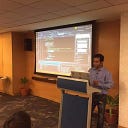Creating .Net Core Microservices using Clean Architecture
Microservices architecture has been gaining a lot of attention lately, and it’s not hard to see why. It offers many benefits, including scalability, resilience, and flexibility. .NET Core is a great platform for building microservices, and when combined with clean architecture, it can lead to even better results. In this blog post, we’ll explore the best practices for building .NET Core microservices using clean architecture, and we’ll touch on some of the tools and technologies that can help you achieve this.
Clean architecture is an approach to designing software systems that emphasizes separation of concerns and independence of implementation details. It has four main layers: the domain layer, the application layer, the infrastructure layer, and the presentation layer. Each layer has a specific role to play in the system, and they communicate with each other through well-defined interfaces.
Github Link:- https://github.com/rahulsahay19/eShopping
When building microservices using clean architecture, it’s important to keep the following best practices in mind:
- Use Docker and Kubernetes for containerization and orchestration. This allows you to deploy and manage your microservices more efficiently, and it makes it easier to scale them up or down as needed.
- Use Identity Server 4 for secure authentication and authorization. This is particularly important for microservices, which are often accessed by multiple clients and need to be protected from unauthorized access.
- Use Rabbit MQ for messaging between microservices. This allows you to decouple your microservices and make them more resilient to failures.
- Use Angular 15 for your front-end application. This is a popular and powerful framework for building single-page applications, and it integrates well with .NET Core.
- Use GRPC for efficient communication between microservices. This is a high-performance, open-source framework for building distributed systems.
- Use Istio Service Mesh for managing microservices traffic. This provides a flexible and powerful way to manage traffic between microservices, and it makes it easier to add new features or make changes without disrupting the system.
- Use SQL Server, MongoDB, PostGreSQL, or Redis for your data storage needs. Each of these databases has its own strengths and weaknesses, so choose the one that best fits your specific use case.
- Use Ocelot and Nginx for managing your microservices API gateway. This allows you to consolidate your API endpoints and provide a unified interface to your clients.
- Use Azure for your cloud hosting needs. Azure is a powerful and flexible cloud platform that integrates well with .NET Core and provides many useful tools and services for building and deploying microservices.
- Use Helm Charts for packaging and deploying your microservices. This allows you to create reusable deployment artifacts and makes it easier to deploy your microservices to different environments.
- Use auto-scaling to ensure your microservices can handle varying levels of traffic. This allows you to scale your microservices up or down automatically based on demand, which can help you save money and improve performance.
In conclusion, building .NET Core microservices using clean architecture is a great way to take advantage of the many benefits of microservices while keeping your code clean and maintainable. By following these best practices and using the right tools and technologies, you can build scalable, efficient, and robust microservices that meet the needs of your users and your business.
So what’s next for you? Whether you’re just starting out with microservices development, or looking to take your skills to the next level, there’s always more to learn. With our “Microservices learning series” course and “Docker & Kubernetes for .NET and Angular Developers” course, you can gain a deeper understanding of the tools and practices used in modern microservices development, and start building robust, scalable applications. So what are you waiting for? Enroll now, and take your first step towards becoming a microservices development expert.
Creating .Net Core Microservices using Clean Architecture
Securing Microservices using Identity Server 4
Implementing Cross-cutting Concerns for ASP.NET Microservice
Building eCommerce Angular Application
Deploying Microservices to Kubernetes and AKS
And for Microservices, docker and kubernetes are required. Hence, in order to make yourself comfortable, I would suggest to take the below course.
Docker & Kubernetes for .NET and Angular Developers
Thanks,
Rahul
Happy Coding
Originally published at My View.
